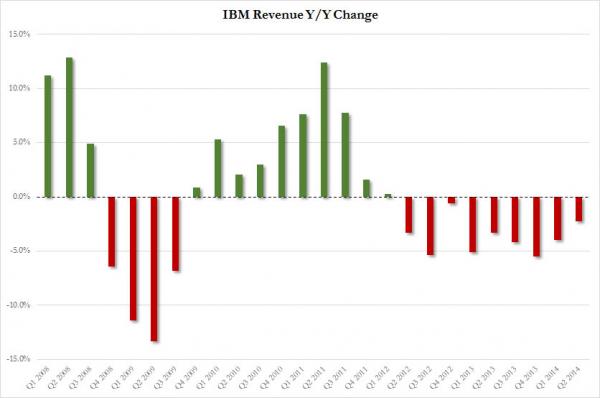IBM is a poster child for the ill-effects of the Fed’s financial repression. In effect, the Fed’s zero interest rate policies are telling big companies to issue truckloads of debt and use the proceeds to buyback shares hand-over-fist. That way fast money speculators on Wall Street are appeased by the resulting share price lift, and top executives collect bigger winnings on their stock options.
In its recently completed quarter, IBM again repurchased nearly $4 billion of stock—which amounted to about 93% of its net income for Q2. Likewise, IBM also reported lower sales versus prior year for the ninth quarter in a row.Â
Â

This juxtaposition should not be surprising. For more than a decade now, IBM has been eating its seed corn. Since the beginning of fiscal 2004, Big Blue has posted $131 billion in cumulative net income, but saw fit to reinvest fully $124 billion or 95% of its earnings in its own balance sheet, which is to say, in buying back its own stock.
At the same time, it also paid out nearly $30 billion in dividends. In combination, therefore, it disgorged $153 billion in buybacks and dividends—-or 117% of its net income! And this wasn’t a temporary maneuver: These figures represent the results of IBMs last 42 quarters. In short, IBM has become a stock price inflation machine, driven by the pressures and opportunities emanating from the Wall Street casino fostered by the Fed.
During that same period, IBM invested a mere $45 billion in CapEx, and that was hardly 90% of its charges for depreciation and amortization of existing capital assets. Given the fact that Capex is measured in current dollars, and D&A allowances are expressed in historical dollars, it is evident that in real terms IBM has been drastically underinvesting in its capital base.
Moreover, the same thing is true when the investment component that is charged to the current P&L is examined. As a giant in the global technology industry, IBM needs to spend heavily on research, development and engineering (RD&E) to keep up with the competition. But it hasn’t. During fiscal 2013 it spent $6.2 billion on RD&E—but that represented a 14% decline in real terms from the $7.2 billion (2013$) it spent ten years ago.

